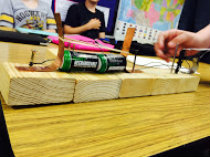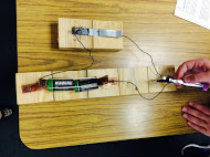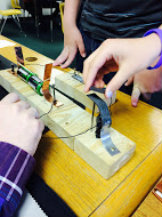Getting Gritty in History Class with PBL Unit
A MiddleWeb Blog
By Jody Passanisi
It’s all the rage now to talk about “grit” and what it means for students. Those who have grit, according to some theorists and researchers, will have success in the classroom.
In her writing about fixed intelligence vs. growth mindset, Carol Dweck posits that students who try and fail, but who think that they can learn and achieve and gain knowledge, will ultimately do better than those who believe their intelligence is fixed and immovable.
Grit is what allows students to gain the courage to keep trying and failing, to work when it’s a challenge, and to not give up and utter that oft-repeated phrase: “I can’t do it.”
This is why the term “self-efficacy”–the feeling that one can achieve with work and dedication– is topping the charts, instead of the 80’s and 90’s darling: “self-esteem.” Grit and self-efficacy–it is our job as teachers to help our students to cultivate these desired traits (because they must be able to be cultivated—that’s the whole point!)
But how do we help students get gritty?

This year, again, my students took the prompt and ran with it. As in years past, there was a wide swath of project styles: some students blogged, others chose to create Prezis, some made actual Civil War style food, and many used technologies and applications such as TinkerCad and MakerBot to create models and mini replicas of Civil War weaponry and warships.
A hands-on challenge
But the group that made me start thinking about this idea of grit was my team that made the telegraph. These students were so in earnest and so intent on making a working telegraph that could transmit messages from one room to another–or at least across the room–that they worked for hours both in class and out.
Their level of motivation and drive was impressive, but what was most interesting about this team was how often they failed. I’m not sure teachers give students enough opportunities to fail. I’ll confess that I’ve felt my job is to help them not fail. But this idea of grit–the ability to fall down or come to a dead end and then get back up and fix it as best you can–is all about trial and error, including the possibility of some serious, discouraging failure.

Finally, they stripped my safety scissors, taking them apart to build the conductor for the current. They still were having trouble getting the scissors to stay upright. But with effort, and problem solving, and trial and error, they made (in their words) a “basically functioning telegraph.”
Setbacks overcome
Listing the phases they went through like this makes their process sound straightforward, when in reality, there was much sturm und drang each time their work failed. They were so invested and then disappointed when what they tried almost worked, but didn’t quite. It would have been easier to give up. But they kept going. They found the wherewithal to tolerate the feeling of being uncertain and uncomfortable, in the problem solving stage.
They came into class having thought about the problem the night before, energized and excited to try a new way to make their telegraph work. They enlisted help and advice, but ultimately, they triumphed over the obstacles themselves.
 Curbing our enthusiasm to help
Curbing our enthusiasm to help
Now, the next time they have a problem, one would hope that instead of giving up and saying “I can’t,” they will remember – physically, mentally and emotionally – the work that they put into building this device and how they achieved their goal ONLY after a great deal of effort and failure. That is self-efficacy.
I imagine that my challenge in the future will be to curb my instinct to fix things for my students and instead allow them to fail enough so they learn to pick themselves up and keep going. Our students really do need to learn not to just rely on us to solve the hard problems for them. If they do, then when it really matters, they will know that they can figure things out on their own.
How do you help students to get “gritty” in social studies class?


 Curbing our enthusiasm to help
Curbing our enthusiasm to help

































Great story, Jody! This goes very well with my recent blog post about how PBL builds grit, have you seen it?
http://bie.org/blog/grit_happens_in_pbl
I hadn’t, but I just read it. Thank you for sharing it. Seems like we are of a similar mind!
Would you mind posting a comment on my blog with a link to yours? People would love to see your example. Thanks.